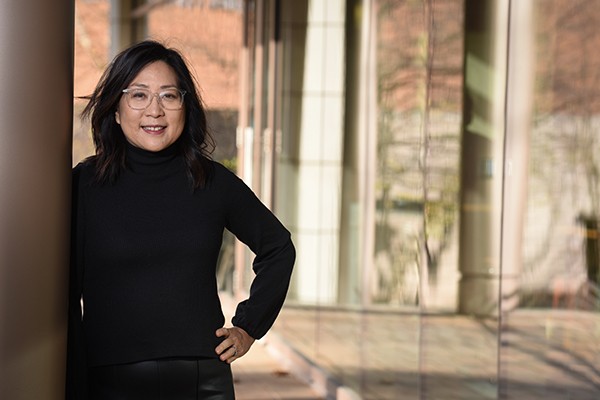Fabric colors created with invasive dyes include coffee, latte, dusty, rose and citron
Invasive Plants for Commercial Use
Invasive plants can have an array of negative ecological effects. In Northeast deciduous forests, for example, invasive plants outcompete natives, disrupt soil nutrient cycling and spread disease that affects humans as well as other plants.
“Invasives are creating increasingly difficult problems across the United States,” says Anne Bower, PhD, professor of biology. “While there are some public and nonprofit efforts to address those problems, we also need to employ free market incentives to overcome this major ecological challenge.” Dr. Bower, Mary Ann Wagner-Graham, PhD, assistant professor of biology, and Becky Flax, MS assistant professor of textile design, have been working with an interdisciplinary group of undergraduate researchers to develop and demonstrate one such approach: using invasive plants to create natural, non-toxic, sustainable alternatives to synthetic dyes.
The researchers’ first step was selecting the plants to use in their experiments. “We sought invasives that have potentially useful properties for creating textiles and which are known to create problems for human health or ecological balance,” Flax explains. They chose three specific types of plants to investigate: Japanese barberry, which supports black-legged tick populations and, thus, promotes higher incidences of Lyme disease; wineberry, which hosts viruses affecting native herbaceous species; and Oriental bittersweet, which causes trunk failure in native species.
In the initial phase of a multifaceted project, the researchers—who included students from the pre-medical sciences, biology, health sciences and textile design programs—harvested roots of those types of plants in the Philadelphia area. Then they processed the roots to create an array of dyes that were used to treat hundreds of pieces of organic cotton or wool fabric. “The students then assessed the resulting color quality and color durability,” Flax says. “In addition, they analyzed the dyed fabrics’ antimicrobial properties, compared to control fabrics. While neither wineberry nor bittersweet showed significant microbial inhibition, barberry demonstrated antimicrobial action against Escherichia coli and Staphylococcus aureus—which could make it useful in dying outdoor furniture and work apparel.”
What’s next in this multi-phase project? Having analyzed dyes from the roots of the three invasives, the researchers will conduct detailed experiments on the dying and antimicrobial capacities of the plants’ berries, stems and leaves. But they won’t stop there, Dr. Bower notes: “This research initiative is not focused solely on harvesting and using invasive plants. We will complete the environmental restoration process by replanting the grounds with resilient species native to the region.”


